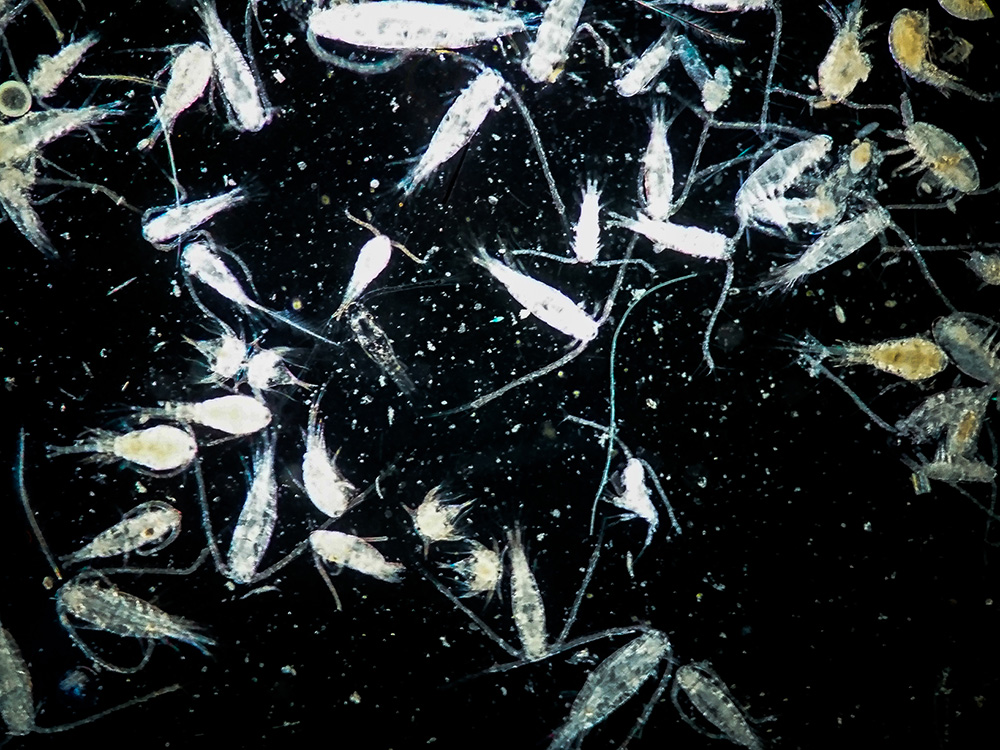
Zooplankton, weakly swimming animals belonging to many phyla (primary divisions of the animal kingdom), which, as larvae or adults, exist wholly suspended within a water body. The marine zooplankton is dominated by copepod crustaceans, found in great numbers in all oceans. The following organisms appear in lesser quantities in the zooplankton: euphausiid crustaceans (eg, krill), chaetognaths (arrow worms), pteropods (small gastropod molluscs), tunicates (protochordates), ctenophores (comb jellies) and jellyfish. Animals that are planktonic for only part of their lives include clam, crab and barnacle larvae, and fish eggs and larvae. Hundreds of species occur in Canadian waters but few exclusively. Locomotion is by movement of structures resembling oars, wings or fins; by cilia (hairlike appendages); or even by jet propulsion. Zooplankton range from zooflagellates a few micrometres long, to large jellyfish. Most feed on smaller particles, including phytoplankton (microscopic plants), using sievelike devices which may function like flypaper rather than sieves because viscous forces prevail in water at such small scales of motion. Other planktonic animals are omnivores or carnivores. Several steps in the food chain can occur within the PLANKTON if the dominant primary producers are very small (under 1 um), eg, cyanobacteria (see BLUE-GREEN ALGAE). Because energy is lost at each step, the elaborate food webs characteristic of warmer, offshore waters usually do not produce commercially exploitable quantities of fish. Japanese and Russian researchers have tried to improve on the chain by harvesting krill for human consumption. Krill and copepod crustaceans added to the diets of AQUACULTURED salmon, trout, etc, improve flesh colour.
Zooplankton occur everywhere in fresh or salt water if oxygen is present. Usually, more and larger specimens representing fewer species are found near shore, near the surface and at high latitudes. Fewer, smaller, more diverse plankton occur offshore. Adaptations for pelagic (open sea) existence may include gas-filled floats, but most animals probably adjust their internal ionic composition to regulate buoyancy. Elaborate fans of setae (bristles) or tentacles probably serve for feeding, for flotation and as sensors. Where light penetrates, animals are often transparent to avoid detection by prey or predators.
Near the surface, blue pigment, offering camouflage and protection from ultraviolet light, is common. In the twilight zone, farther down, animals are darker and frequently possess light-producing organs (photophores) or produce light-emitting (bioluminescent) secretions. Bioluminescence may countershade the animal when seen from below, or may confuse predators or serve as an intraspecific recognition signal, but its adaptive role remains in dispute. The daily migrations, often of hundreds of metres, made by many zooplankters are little understood, although reduced predation at night is advantageous to herbivorous forms seeking near-surface phytoplankton concentrations.
Exclusively marine and largely planktonic comb jellies and arrow worms are important zooplankters; comb jellies because of their numbers and predatory impact; arrow worms because of their value as indicators of water quality. Comb jellies, jellyfishlike animals which swim with 8 rows of comb plates, capture food with entangling colloblasts (adhesive cells). Most are bioluminescent. Larvae of most species have tentacles; in some adults, tentacles act as a net to capture other zooplankton. Arrow worms belong to a coelomate phylum of uncertain affinities. Most are transparent ambush-predators, capturing other zooplankton with 8-12 pairs of bony, raptorial spines.

 Share on Facebook
Share on Facebook Share on X
Share on X Share by Email
Share by Email Share on Google Classroom
Share on Google Classroom



